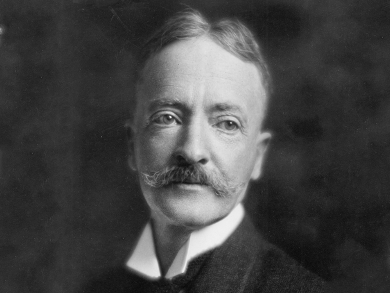William Lash Miller was born on September 10, 1866, in Galt, ON, Canada. He started out studying classics at the University of Toronto, ON, Canada, but later switched to natural sciences. He received his Bachelor’s degree in 1887 and went to Europe to continue his studies, a common phenomenon at the time.
Miller chose to move to Germany, where he worked with August Wilhelm von Hofmann from 1887 to 1889 in Berlin, with Victor Meyer in 1889 in Göttingen, and then with Adolf von Baeyer in Munich. He received his Ph.D. in organic chemistry in Munich in 1890. The same year, he joined Wilhelm Ostwald in Leipzig, Germany, who influenced Miller profoundly. He introduced him to physical chemistry and to the revolutionary theories in thermodynamics put forward by Josiah Willard Gibbs.
Gibbs’ thermodynamics papers were highly mathematical and struggled to find a large following in North America. After his return to Canada, Miller became one of the first proponents of the theory there, helped to put it into more practical terms, and increased its reach. William Lash Miller joined the teaching staff at the University of Toronto in 1891. However, he traveled to Leipzig in 1892 to finish a second Ph.D. under Ostwald. He returned to Toronto and was promoted to Lecturer in 1894.
The head of the chemistry department at the time, William Herbert Pike, had groomed Miller to be his successor, but when Pike resigned in 1898, another chemist was appointed to the position. This caused Miller to complain to the ministry responsible for the decision, one of many disagreements Miller is said to have had with the administration, colleagues, and competing departments at the university over the years. Still, Miller remained in Toronto and was appointed Associate Professor in 1900, Full Professor of Physical Chemistry in 1908, and finally became the de facto Department Head in 1914. He remained in Toronto until his retirement in 1937, and helped to shape the research activities and the international reputation of the department. Miller worked on many aspects of physical chemistry, including thermodynamics, kinetics, and electrochemistry.
Miller, while highly respected for his research, refused to accept and teach atomic and molecular theory. This influenced and somewhat distorted chemical teaching in Toronto for decades. Nevertheless, he was regarded as one of the most influential Canadian chemists of his time. He was President of the Electrochemical Society in 1912 and 1913, President of the Canadian Institute of Chemistry (today’s Canadian Society of Chemistry) in 1926, became the first Canadian Honorary Member of the the American Chemical Society (ACS) that same year, and was made a Commander of the British Empire in 1935.
Miller was a friend of Wilder Bancroft, who founded the Journal of Physical Chemistry in 1896, and worked as Associate Editor for this journal and for the Journal of the American Chemical Society. After his retirement, Miller focused on biochemistry. William Lash Miller died on September 1, 1940, in Toronto.
William Lash Miller is the answer to Guess the Chemist (57).
Sources
- Historical Distillates: Chemistry at the University of Toronto since 1843,
Adrian G. Brook, W. A. E. (Peter) McBryde,
Dundurn, Toronto, 2007.
ISBN 978-1-55002-724-2 - William Lash Miller,
W. A. E. McBryde,
The Canadian Encyclopedia 2008.
Selected Publications
- Numerical Evaluation of Infinite Series and Integrals which arise in Certain Problems of Linear Heat Flow, Electrochemical Diffusion, etc,
W. L. Miller, A. R. Gordon,
J. Phys. Chem. 1930, 35, 2785–2884.
DOI: 10.1021/j150328a001 - The Method of Willard Gibbs in Chemical Thermodynamics,
W. Lash. Miller,
Chem. Rev. 1925, 1, 293–344.
DOI: 10.1021/cr60004a001 - Toxicity and Chemical Potential,
W. Lash Miller,
J. Phys. Chem. 1919, 24, 562–569.
DOI: 10.1021/j150205a003 - The Influence of Diffusion on Electromotive Force Produced in Solutions by Centrifugal Action,
W. Lash Miller,
Trans. Am. Electrochem. Soc. 1912, 21, 209–217. - Mathematical Theory of the Changes of Concentration at the Electrode brought about by Diffusion and by Chemical Reaction,
T. R. Rosebrugh, W. Lash Miller,
J. Phys. Chem. 1909, 14, 816–884.
DOI: 10.1021/j150117a002 - On the Second Differential Coefficients of Gibbs’ Function ζ. The Vapour Tensions, Freezing and Boiling Points of Ternary Mixtures,
W. Lash. Miller,
J. Phys. Chem. 1897, 1, 633–642.
DOI: 10.1021/j150592a001




